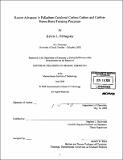Recent advances in palladium-catalyzed carbon-carbon and carbon-boron bond forming processes
Author(s)
Billingsley, Kelvin L
DownloadFull printable version (9.443Mb)
Other Contributors
Massachusetts Institute of Technology. Dept. of Chemistry.
Advisor
Stephen L. Buchwald.
Terms of use
Metadata
Show full item recordAbstract
Chapter 1. Highly active and efficient catalyst systems derived from palladium precatalysts and monophosphine ligands for the Suzuki-Miyaura cross-coupling reaction of heteroaryl boronic acids and esters has been developed. This method allows for the preparation of a wide variety of heterobiaryls in good to excellent yields and displays a high level of activity for the coupling of heteroaryl chlorides as well as hindered aryl and heteroaryl halides. Specific factors that govern the efficacy of the transformation for certain heterocyclic motifs were also investigated. Chapter 2. A highly efficient method for the palladium-catalyzed Suzuki-Miyaura reaction of lithium triisopropyl 2-pyridylborates has been developed. Catalysts comprised of Pd2dba3 and either diaryl or dialkyl phosphine oxide supporting ligands were found to be ideal for the transformation. This report represents one of the most general systems for the cross-coupling of aryl and heteroaryl bromides and chlorides with 2-pyridyl-derived nucleophiles. Chapter 3. Catalysts comprised of Pd and dialkylmonophosphinobiaryl ligands provide highly active systems for the borylation of aryl and heteroaryl chlorides. The direct preparation of symmetrical and unsymmetrical biaryls from two aryl chlorides without the need to isolate the intermediate boronate esters is also described. Additionally, computational studies provide insight into the roles of the biaryl phosphine ligand as well as KOAc in the catalytic cycle. Chapter 4. A highly efficient method for the palladium-catalyzed borylation of aryl halides with an inexpensive and atom-economical boron source, pinacol borane, has been developed. (cont.) This system allows for the conversion of aryl and heteroaryl iodides, bromides and several chlorides, containing a variety of functional groups, to the corresponding pinacol boronate esters. In addition to the increase in substrate scope, this is the first general method where relatively low quantities of catalyst and short reaction times can be employed.
Description
Thesis (Ph. D.)--Massachusetts Institute of Technology, Dept. of Chemistry, 2008. Vita. Includes bibliographical references.
Date issued
2008Department
Massachusetts Institute of Technology. Department of ChemistryPublisher
Massachusetts Institute of Technology
Keywords
Chemistry.